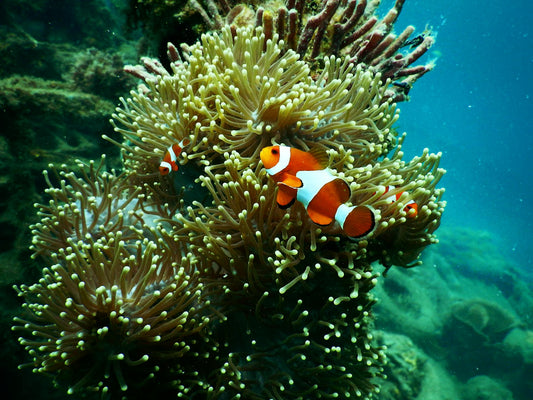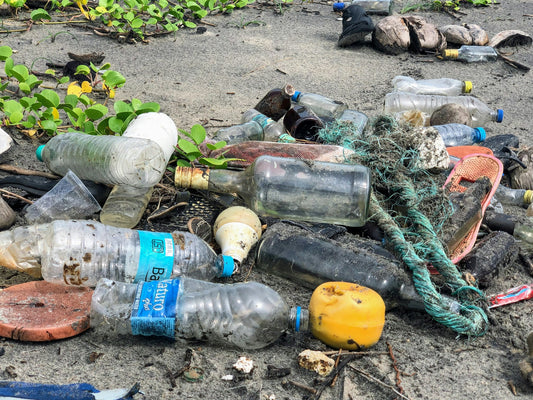Share
Plastic bags have become a ubiquitous part of our lives. Unfortunately the little convenience they bring comes at a big price for the environment:
- their production uses huge amounts of resources
- their usage leaks microplastics and chemicals
- they are the top polluter of our world's oceans
In our new series "The Dirty Truth", we explore everyday items and the role they play in the big theme of pollution.
Today: Plastic Bags.
In this article we’ll shed light on how these "harmless" carriers are threatening our planet across their whole lifecycle.
--------------------------
Plastic bags in numbers
Plastic bags are everywhere and their usage has exploded over the last decades.

500 billion plastic bags are used worldwide every year. That number might be a little hard to grasp. Just imagine that this amounts to 1.37 billion bags per day and and 57 million per hour.
Still hard to imagine? Every minute we use one million plastic bags.
The U.S. are one of the main contributors to this massive plastic bag flood. 100 billion plastic bags are used every year in America.
That is more than 300 bags per person.
With this consumption, the U.S. contribute around 20% of the global total. While Americans apparently love the convenience that comes with plastic bags, other countries globally show what's possible.
Denmark, for instance, brought the average plastic bag usage down to only 4 bags per person per year.
The high usage of plastic bags is especially concerning, if we look at the average lifespan of a plastic bag.
While the average plastic bag is used for only 12 minutes, it can take up to 1000 years to break down. Even then it never fully biodegrades.
Now that we know the rough numbers, let's dive into the pollution that plastic bags cause step by step, starting with their production.
How plastic bags pollute during production

Plastic (bag) production is a resource intensive process that heavily relies on fossil fuels like oil and natural gas.
One of the primary components of plastic bags is polyethylene, a petroleum-based product.
To produce just one plastic bag, approximately 19 grams of oil are consumed.
Now, that might not sound like much. But multiply that by the sheer volume of 500 billion plastic bags used worldwide every year, and it adds up. A staggering 60 million barrels of oil (12 million barrels in the U.S. alone) yearly.
With the average car needing 12 barrels per year, that is enough to fuel 5 million cars over a year.
In addition to this extensive resource consumption, plastic bag production also generates significant emissions.
While the plastic industry loves to advertise the low environmental impact of single use plastic bags, these opinions are comparing apples and oranges.
Yes, it is true that plastic bags produce up to 68% fewer greenhouse gases (GHG) and require only 6% of the water compared to paper bags.
But the analysis is lacking a couple of major aspects:
- Only because they require less water and emit less GHG than another single use solution, does not conclude that they are sustainable. Rather than comparing two single-use products, we should compare plastic bags to reusable alternatives. These can be used hundreds or even thousands of times.
- The advertised sustainability of single use plastic bags completely omits their terrible impact on the environment through usage and disposal (see below).
- While they may emit less CO2 than other materials, the sheer volume still adds up to a significant CO2 impact.
It is estimated that the average CO2 impact of a single use plastic bag is 1.58 kg, which is equivalent to driving 8km.
You see where we are going...
Our 500 billion plastic bags produced every year produce CO2 emissions equivalent to driving 4 trillion kilometers. That's like driving around the earth 100 million times.
Let us take another step in the lifecycle of a plastic bag and see how they pollute the environment during their usage.
How plastic bags pollute during their usage
The main concerns regarding plastic bag usage are related to chemical leakage and microplastics.

Most plastic bags are produced from polyethylene. That's a specific plastic polymer sourced from petroleum or natural gas derivatives.
This polyethylene is liquified and shaped into thin sheets. The sheets are then sliced and heat-sealed into the recognizable bag form.
The bags' usage varies depending on thickness, often serving as single-use bags for items like bread, snacks, and frozen foods.
Similar to plastic bottles, plastic bags contain a whole variety of chemicals like phthalates, bisphenol A (BPA), and polyvinyl chloride (PVC).
These chemical components have the capacity to migrate into food and beverages and can even permeate through the skin.
Many of these additives have adverse health impacts. They've been linked to conditions like cancer, birth defects, and immune system suppression. Both humans and wildlife alike are affected.
- Phthalates play an important role in enhancing the flexibility and durability of plastic bags. They are so called endocrine disruptors, which means they can disrupt hormonal balance. They even cause issues pertaining to reproduction and development.
- BPA also wields the power to disrupt hormonal function. It is deployed to bolster the rigidity of plastic bags.
- PVC, mainly used for waterproofing, can house noxious elements like lead, cadmium, and other toxic compounds.
Another major concern regarding plastic bag usage is the leakage of microplastics.
A study from the University of Portsmouth compared two identical dinners.
Both dinners consisted of chicken, potatoes, carrots, broccoli, and Yorkshire pudding. But there was a notable difference between the two. One meal was prepared using ingredients that had been wrapped in plastic, while the other was not.
The meal made from plastic-stored items contained about seven times more microplastics! In total, the researchers discovered around 230,000 microplastic particles in this dinner.
If you are wondering why that should be a huge "no-no" for using plastic bags, check out our article about microplastics in the human body and its effects.
We don't know about you, but we noticed something during the Covid-19 pandemic: More and more studies were published that promoted plastic bags as healthiest option for food storage.
We urge you to think twice and take them with a grain of salt.
Why?
Because studies like this one are sponsored by industry associations. So it's no surprise that they promote single use plastic bags as the healthiest option for your family.
There are a some big shortcomings in most studies.
- The studies raise a concern that bacteria, such as E. coli and salmonella, can thrive within reused bags. What they "forget" to mention is that this is true for all materials. Including plastic bags.
- The conducted studies tested bags that hadn't been washed or cleaned in months or even years.
- Even in the heavily reused bags tested in the studies, the found strains of bacteria were harmless.
We don't know about you, but to us it seems a lot more compelling to wash our reusable bags every once in a while.
That seems like a good trade-off rather than ingesting microplastics and chemicals from using single-use plastic bags.
How plastic bags pollute after disposal
It may not come as a surprise that the biggest concern around plastic bags is their disposal.

Recycling rates for plastic bags are dishearteningly low. Of the 4.2 million tons of plastic bags that reach U.S. waste management facilities every year, only 10% are recycled.
Most bags end up in landfills (72%), where they release harmful toxins and degrade over hundreds of years. Or they are incinerated (18%), generating toxic fumes and greenhouse gases.
That of course only applies to the plastic bag waste that is actually properly managed.
The OECD estimates that 22% of plastic waste globally will not even reach a proper waste management facility and is mismanaged.
One of the most commonly used practices that fall under this category of mismanaged waste is open burning.
Open burning is a waste management practice that is especially common in South Asia and the developing world. It generates black carbon, a greenhouse gas that is around 5000 times more potent than CO2.
Estimates show that 40-60% of the plastic waste in developing countries is burned that way.
You can imagine the massive impact this has on global warming.
Even worse is the plastic waste that does not get managed at all.
Ocean cleanups and studies show that plastic bags make up around 14% of all ocean plastic. That makes plastic bags the top pollutant of our waterways.
Plastic bags constitute a significant portion of ocean plastic and littered plastic. They contribute to the massive plastic pollution crisis that harms our planet.
They are especially dangerous to sea life. Plastic bags are often mistaken for prey like squid or jellyfish, making them one of the most consumed items.
In fact, it is estimated that 56% of the worlds whale, dolphin, and porpoise population have consumed plastic.
Consequently, plastic is causing the deaths of millions of marine creatures every year.
Estimates are ranging from one million to one hundred million deaths every year, depending on the species.
Plastic bags are part of our pollution crisis
In a world of convenience, plastic bags have taken over our lives. But these carriers come with a hefty price for the environment.
Around 500 billion plastic bags get used worldwide every year, 1.37 billion every single day.
America plays a big role, using over 100 billion bags annually, contributing about 20% of the global mess.
Plastic bags are used for only 12 minutes on average, but they stick around for generations. They pollute our waterways and break down into microplastics.
Producing them is a similar mess. It takes tons of oil and gas, exhausting significant greenhouse gases.
And yeah, they're even affecting our own health. Chemicals and microplastics from plastic bags are leaking into our food and drinks.
They're clogging up our oceans, harming wildlife, and spreading pollution - all for 12 minutes of convenience.
So what can we do about it?
So what can we do about it? Its easy!
We need stop using plastic bags and we need to do it now!
If you think about the times you use plastic bags, there are great alternatives!
Shopping groceries? Take a tote bag!

Buying Produce or Bulk? Organic Mesh Bags and Muslin Bags have you covered!

It's time to SWOP plastic bags out for eco-friendly options now and start using reusable alternatives.
Want to read the other two articles in our series "The Dirty Truth"? Here you go!
The Dirty Truth: How Much Plastic Water Bottles Really Contribute to Pollution (2023)
The Dirty Truth: How Much Plastic Straws Really Contribute to Pollution (2023)
We hope you enjoyed this article. If you want to read more like this, make sure to check out our Blog and follow us on Instagram. If you are interested in truly sustainable products, check out our Shop.
If you want to engage in the discussion, feel free to leave a comment below.








